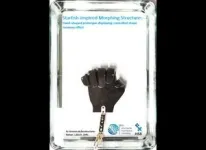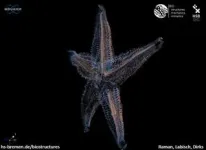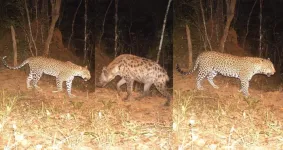(Press-News.org) While the impact of wildfires on terrestrial life has been well studied, only recently has research started to examine the effects of wildfire ash on aquatic organisms. New research reveals that wildfire ash can have lethal consequences on Australian water ecosystems.
Wildfires are becoming more prevalent due to the warming and drying effects of climate change, with Australia becoming especially vulnerable to dangerous bushfires. “Therefore, many Australian species may be threatened by fires,” says Miss Jenelle McCuaig, a Masters student at the University of Alberta, Canada. “This is putting them at greater risk of endangerment and possible extinction.”
Wildfires release ash into the air, which can enter aquatic environments directly or be washed into bodies of water by rainfall. “Once in the water, ash may leach metals and organic combustion products, where they can affect organisms, acquired by ingestion through intestines or respiration through gills,” says Miss McCuaig. There are also serious consequences for humans, as we rely on healthy freshwater ecosystems for water and food.
Miss McCuaig and her team focused their research on two common Australian crustacean species, a crayfish (Cherax destructor) and a shrimp (Macrobrachium australiense).
To examine the effects of wildfire ash on the crustaceans, each species was exposed to a range of ash concentrations to determine their sensitivity and likelihood of survival. Miss McCuaig then measured their oxygen consumption using a respirometry system and took tissue samples to look at their metabolic activity.
After exposure to just 5g of ash per litre of water, Miss McCuaig found that no shrimps could survive – but it took 8 times as much ash to reach complete crayfish mortality. “The huge difference in sensitivity between the two species was much greater than I expected,” says Miss McCuaig.
This research shows that even between similar species, there can be a big difference in survival response to environmental stressors such as wildfire ash. “Differences in body shape and gill structure, as well as habitat preferences, has allowed them to fulfil different niches,” says Miss McCuaig. “Crayfish demonstrated greater resilience to the ash exposure compared to the shrimp.”
For the surviving crayfish and shrimp, the individuals exposed to the highest concentrations of ash had the highest metabolic rates, suggesting a high level of physiological stress. “This is particularly concerning during ash exposure, because increased ventilation means that the animals will be taking up more of the ash particles and leached contaminants from the water, further affecting their body systems.”
“This research will allow us to identify the species that are most threatened by fires and help to inform the development of breeding programs or relocation efforts,” says Miss McCuaig. “When it comes to wildfires, resources are limited, so we must prioritise response actions.”
Miss McCuaig adds that even though many wildfires occur naturally, humans still have a responsibility to protect the living world: “Species conservation begins with wildfire prevention in the first place - it is incredibly important to be educated about, and to implement, fire-safety into our lives to mitigate human-caused wildfires”.
This research was made possible by funding from The Company of Biologists, Natural Sciences and Engineering Research Council of Canada, and the Society for Experimental Biology, as well as collaboration of the Blewett Lab and Franklin Eco-Laboratory.
This research is being presented at the Society for Experimental Biology Annual Conference in Prague on the 2-5th July 2024.
END
Australian bushfire ash is deadly for aquatic life
2024-07-02
ELSE PRESS RELEASES FROM THIS DATE:
Starfish skeleton inspires new 4D morphing structure
2024-07-02
Researchers have recently developed a flexible-yet-sturdy morphing structure inspired by the starfish skeleton that exhibits 4D morphing features with promising applications for robotics, aviation, and medical devices.
“Starfish possess the remarkable ability to effortlessly hold themselves in any body posture by changing the stiffness of their endoskeleton,” says Raman, a PhD student in the Biological Structures and Biomimetics workgroup at Hochschule Bremen - City University of Applied Sciences Bremen, Germany.
Ossicles are calcite microstructures inside starfish bodies that are connected in a ...
Eating more soy foods could improve thinking and attention in kids
2024-07-02
Chicago (July 2, 2024) — A new study found that school-aged children who consumed more isoflavones from soy foods exhibited better thinking abilities and attention. These findings pave the way for future research aimed at unraveling how soy foods can positively impact children's cognitive abilities.
Isoflavones are naturally occurring compounds found in various plants, particularly soybeans and soy products. Although previous research in adults has suggested that soy isoflavones can improve memory, the ...
Changes in emergency contraceptive fills after Massachusetts’ statewide standing order
2024-07-02
About The Study: The Massachusetts statewide standing order policy was associated with a 32% increase in emergency contraceptive fills at pharmacies versus comparison states. After the policy, fills for prescription-only ulipristal more than doubled and accounted for the observed increases in fills for emergency contraceptives.
Corresponding Author: To contact the corresponding author, Dima M. Qato, Pharm.D., M.P.H., Ph.D., email qato@usc.edu.
To access the embargoed study: Visit our For The Media website at this link https://media.jamanetwork.com/
(doi:10.1001/jama.2024.11715)
Editor’s ...
Bacteria detected in tattoo and permanent makeup inks
2024-07-02
Washington, D.C.—Researchers have detected anaerobic and aerobic bacteria in commercial tattoo and permanent makeup inks. The findings, reported in Applied and Environmental Microbiology, a journal of the American Society for Microbiology, demonstrate that the inks could be a source of human infections. The new study is particularly notable as it is the first to investigate the presence of anaerobic bacteria in commercial tattoo inks.
“Our findings reveal that unopened and sealed tattoo inks can harbor anaerobic bacteria, known to thrive in low-oxygen environments like ...
American Indian/Alaska Native patients less likely to undergo breast reconstruction
2024-07-02
Waltham — July 2, 2024 — American Indian/Alaska Native (AI/AN) women with breast cancer have consistently lower rates of breast reconstruction after mastectomy compared to non-Hispanic White women, reports a paper in the July issue of Plastic and Reconstructive Surgery®, the official medical journal of the American Society of Plastic Surgeons (ASPS). The journal is published in the Lippincott portfolio by Wolters Kluwer.
"Despite an upward trend in reconstruction, AI/AN women continue to be less likely to undergo breast reconstruction," comments Jane Hui, MD, MS, ...
Prosocial influencers can promote societal cooperation
2024-07-02
A modeling study suggests that influential neighbors can be as effective as despotic leaders at promoting social cooperation. Prosocial behaviors can be difficult to sustain in large societies over the long term, as people give into the temptation to defect to strategies that prioritize the wellbeing of themselves and their immediate family. Stefani Crabtree and colleagues constructed a general theoretical framework to explore how cooperation could arise and be maintained in a large society. The authors explore three possible ...
SRF launches the SYNGAP1 missense account with Nordmoe family donation
2024-07-02
Mill Valley, CA – June 18, 2024 SRF has established a dedicated account to support research regarding SYNGAP1 missense variants. This account is being launched with a $10,000 donation from Dennis and Janet Nordmoe. This is a cause close to their hearts, as their granddaughter Olivia was diagnosed with SYNGAP1-Related Disorder (SRD) caused by a missense variant earlier this year.
Missense Research: Neglected to Date
“Most diagnosed SYNGAP1-Related Disorder (SRD) patients have protein truncating variants (PTV) as opposed to missense variants. Virtually all PTVs are assumed to have the ...
Design and development of a novel light sheet fluorescence microscope
2024-07-02
Three-dimensional (3D) imaging of organs and tissues is vital as it can provide important structural information at the cellular level. 3D imaging enables the accurate visualization of tissues and also helps in the identification of pathological conditions. However, achieving successful 3D imaging necessitates specific prerequisites, including the preparation of 'cleared' tissue samples—biological specimens rendered transparent by removing light-scattering components like lipids to ...
How to promote menstrual cups as an economic and sustainable option
2024-07-02
In recent decades, single-use plastics have pervaded modern societies, causing a significant surge in plastic pollution that exacts a heavy toll on our environment. Addressing this issue requires prioritizing sustainable alternatives to single-use plastics wherever feasible.
Disposable menstrual products are a notable contributor to plastic waste, with billions of sanitary napkins and tampons being discarded every year. Despite the availability of sustainable options like menstrual cups (MCs), consumer preference for single-use products ...
Spotted apex predator being pressured by spotted pack hunters – and it's our fault
2024-07-02
Who’s stronger? A solitary leopard or cackle of hyenas? And which is best at getting along with humans?
University of Copenhagen researchers closely studied this in a large East African natural area surrounded by rural settlements. The study demonstrates that the presence of humans has a direct impact on the competitive relationship between the two large predator species: leopards (Panthera pardus) – the iconic spotted feline and the spotted hyena (Crocuta crocuta) – a kleptoparasite and pack hunter known for its comical ...







